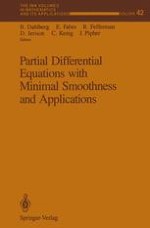1992 | Buch
Partial Differential Equations with Minimal Smoothness and Applications
herausgegeben von: B. Dahlberg, R. Fefferman, Carlos Kenig, Eugene Fabes, David Jerison, J. Pipher
Verlag: Springer New York
Buchreihe : The IMA Volumes in Mathematics and its Applications
Enthalten in: Professional Book Archive
